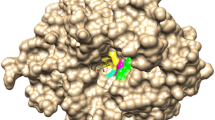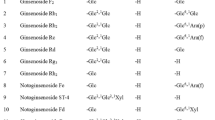Abstract
A recombinant β-glucosidase from Clavibacter michiganensis specifically hydrolyzed the outer and inner glucose linked to the C-3 position in protopanaxadiol (PPD)-type ginsenosides and the C-6 position in protopanaxatriol (PPT)-type ginsenosides except for the hydrolysis of gypenoside LXXV (GypLXXV). The enzyme converted gypenoside XVII (GypXVII) to GypLXXV by hydrolyzing the inner glucose linked to the C-3 position. The substrate-binding residues obtained from the GypXVII-docked homology models of β-glucosidase from C. michiganensis were replaced with alanine, and the amino acid residue at position 512 was selected because of the changed regioselectivity of W512A. Site-directed mutagenesis for the amino acid residue at position 512 was performed. W512A and W512K hydrolyzed the inner glucose linked to the C-3 position and the outer glucose linked to the C-20 position of GypXVII to produce GypLXXV and F2. W512R hydrolyzed only the outer glucose linked to the C-20 position of GypXVII to produce F2. However, W512E and W512D exhibited no activity for GypXVII. Thus, the amino acid at position 512 is a critical residue to determine the regioselectivity for the hydrolysis of GypXVII. These wild-type and variant enzymes produced diverse ginsenosides, including GypXVII, GypLXXV, F2, and compound K, from ginsenoside Rb1. To the best of our knowledge, this is the first report of the alteration of regioselectivity on ginsenoside hydrolysis by protein engineering.





Similar content being viewed by others
References
Al-Balas Q, Hassan M, Al-Oudat B, Alzoubi H, Mhaidat N, Almaaytah A (2012) Generation of the first structure-based pharmacophore model containing a selective “zinc binding group” feature to identify potential glyoxalase-1 inhibitors. Molecules 17:13740–13758
An DS, Cui CH, Lee HG, Wang L, Kim SC, Lee ST, Jin F, Yu H, Chin YW, Lee HK, Im WT, Kim SG (2010) Identification and characterization of a novel Terrabacter ginsenosidimutans sp. nov. β-glucosidase that transforms ginsenoside Rb1 into the rare gypenosides XVII and LXXV. Appl Environ Microbiol 76:5827–5836
Bae EA, Han MJ, Kim EJ, Kim DH (2004) Transformation of ginseng saponins to ginsenoside Rh2 by acids and human intestinal bacteria and biological activities of their transformants. Arch Pharm Res 27:61–67
Choi WY, Lim HW, Lim CJ (2013) Anti-inflammatory, antioxidative and matrix metalloproteinase inhibitory properties of 20(R)-ginsenoside Rh2 in cultured macrophages and keratinocytes. J Pharm Pharmacol 65:310–316
Cui CH, Kim SC, Im WT (2013a) Characterization of the ginsenoside-transforming recombinant β-glucosidase from Actinosynnema mirum and bioconversion of major ginsenosides into minor ginsenosides. Appl Microbiol Biotechnol 97:649–659
Cui CH, Liu QM, Kim JK, Sung BH, Kim SG, Kim SC, Im WT (2013b) Identification and characterization of a Mucilaginibacter sp. strain QM49 β-glucosidase and its use in the production of the pharmaceutically active minor ginsenosides (S)-Rh1 and (S)-Rg2. Appl Environ Microbiol 79:5788–5798
Hong H, Cui CH, Kim JK, Jin FX, Kim SC, Im WT (2012) Enzymatic biotransformation of ginsenoside Rb1 and gypenoside XVII into ginsenosides Rd and F2 by recombinant β-glucosidase from Flavobacterium johnsoniae. J Ginseng Res 36:418–424
Kim JK, Cui CH, Yoon MH, Kim SC, Im WT (2012) Bioconversion of major ginsenosides Rg1 to minor ginsenoside F1 using novel recombinant ginsenoside hydrolyzing glycosidase cloned from Sanguibacter keddieii and enzyme characterization. J Biotechnol 161:294–301
Kim MK, Lee JW, Lee KY, Yang DC (2005) Microbial conversion of major ginsenoside Rb1 to pharmaceutically active minor ginsenoside Rd. J Microbiol 43:456–462
Kim WY, Kim JM, Han SB, Lee SK, Kim ND, Park MK, Kim CK, Park JH (2000) Steaming of ginseng at high temperature enhances biological activity. J Nat Prod 63:1702–1704
Laskowski RA, Moss DS, Thornton JM (1993) Main-chain bond lengths and bond angles in protein structures. J Mol Biol 231:1049–1067
Noh KH, Son JW, Kim HJ, Oh DK (2009) Ginsenoside compound K production from ginseng root extract by a thermostable β-glycosidase from Sulfolobus solfataricus. Biosci Biotechnol Biochem 73:316–321
Oh HA, Seo JY, Jeong HJ, Kim HM (2013) Ginsenoside Rg1 inhibits the TSLP production in allergic rhinitis mice. Immunopharmacol Immunotoxicol 35:678–686
Park EH, Kim YJ, Yamabe N, Park SH, Kim HK, Jang HJ, Kim JH, Cheon GJ, Ham J, Kang KS (2014) Stereospecific anticancer effects of ginsenoside Rg3 epimers isolated from heat-processed American ginseng on human gastric cancer cell. J Ginseng Res 38:22–27
Quan LH, Wang C, Jin Y, Wang TR, Kim YJ, Yang DC (2013) Isolation and characterization of novel ginsenoside-hydrolyzing glycosidase from Microbacterium esteraromaticum that transforms ginsenoside Rb2 to rare ginsenoside 20(S)-Rg3. Anton Leeuw Int J G 104:129–137
Shin KC, Oh DK (2013) Characterization of a novel recombinant β-glucosidase from Sphingopyxis alaskensis that specifically hydrolyzes the outer glucose at the C-3 position in protopanaxadiol-type ginsenosides. J Biotechnol 172C:30–37
Son JW, Kim HJ, Oh DK (2008) Ginsenoside Rd production from the major ginsenoside Rb1 by β-glucosidase from Thermus caldophilus. Biotechnol Lett 30:713–716
Tan S, Zhou F, Li N, Dong Q, Zhang X, Ye X, Guo J, Chen B, Yu Z (2013) Anti-fatigue effect of ginsenoside Rb1 on postoperative fatigue syndrome induced by major small intestinal resection in rat. Biol Pharm Bull 36:1634–1639
Tirado-Rives J, Jorgensen WL (2006) Contribution of conformer focusing to the uncertainty in predicting free energies for protein-ligand binding. J Med Chem 49:5880–5884
Varghese JN, Hrmova M, Fincher GB (1999) Three-dimensional structure of a barley β-D-glucan exohydrolase, a family 3 glycosyl hydrolase. Structure 7:179–190
Wang L, Liu QM, Sung BH, An DS, Lee HG, Kim SG, Kim SC, Lee ST, Im WT (2011) Bioconversion of ginsenosides Rb1, Rb2, Rc and Rd by novel β-glucosidase hydrolyzing outer 3-O glycoside from Sphingomonas sp. 2 F2: cloning, expression, and enzyme characterization. J Biotechnol 156:125–133
Wu H, Chen J, Wang Q, Jia X, Song S, Yuan P, Liu K, Liu L, Zhang Y, Zhou A, Wei W (2014) Ginsenoside metabolite compound K attenuates inflammatory responses of adjuvant-induced arthritis rats. Immunopharmacol Immunotoxicol. 36:124–129
Zhao L, Xie J, Zhang X, Cao F, Pei J (2013) Overexpression and characterization of a glucose-tolerant-glucosidase from Thermotoga thermarum DSM 5069 T with high catalytic efficiency of ginsenoside Rb1 to Rd. J Mol Catal B Enzym 95:62–69
Zhou W, Yan Q, Li JY, Zhang XC, Zhou P (2008) Biotransformation of Panax notoginseng saponins into ginsenoside compound K production by Paecilomyces bainier sp. 229. J Appl Microbiol 104:699–706
Acknowledgments
This paper was supported by Konkuk University in 2014.
Author information
Authors and Affiliations
Corresponding author
Electronic supplementary material
Below is the link to the electronic supplementary material.
ESM 1
(DOC 3650 kb)
Rights and permissions
About this article
Cite this article
Shin, KC., Hong, SH., Seo, MJ. et al. An amino acid at position 512 in β-glucosidase from Clavibacter michiganensis determines the regioselectivity for hydrolyzing gypenoside XVII. Appl Microbiol Biotechnol 99, 7987–7996 (2015). https://doi.org/10.1007/s00253-015-6549-6
Received:
Accepted:
Published:
Issue Date:
DOI: https://doi.org/10.1007/s00253-015-6549-6




